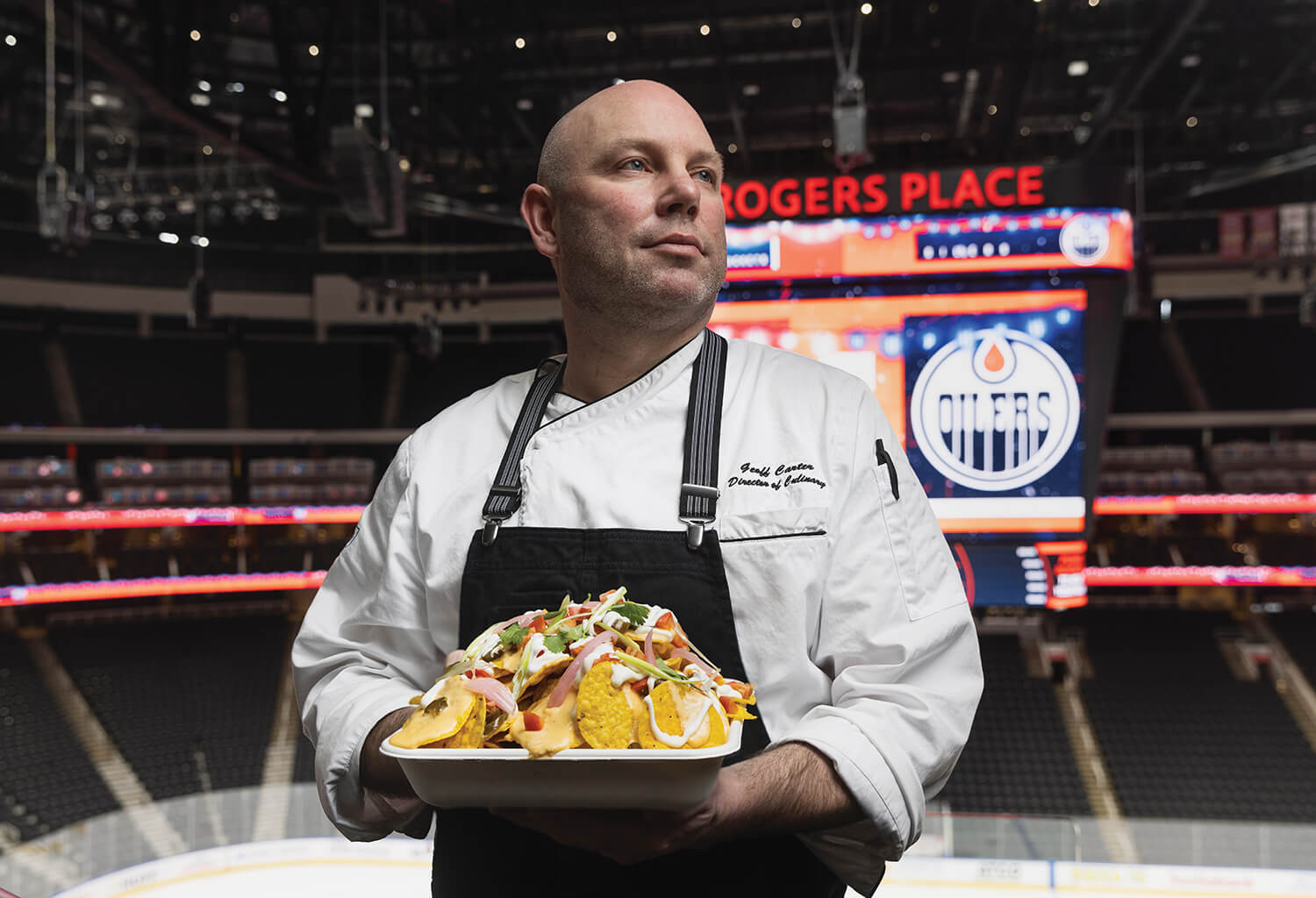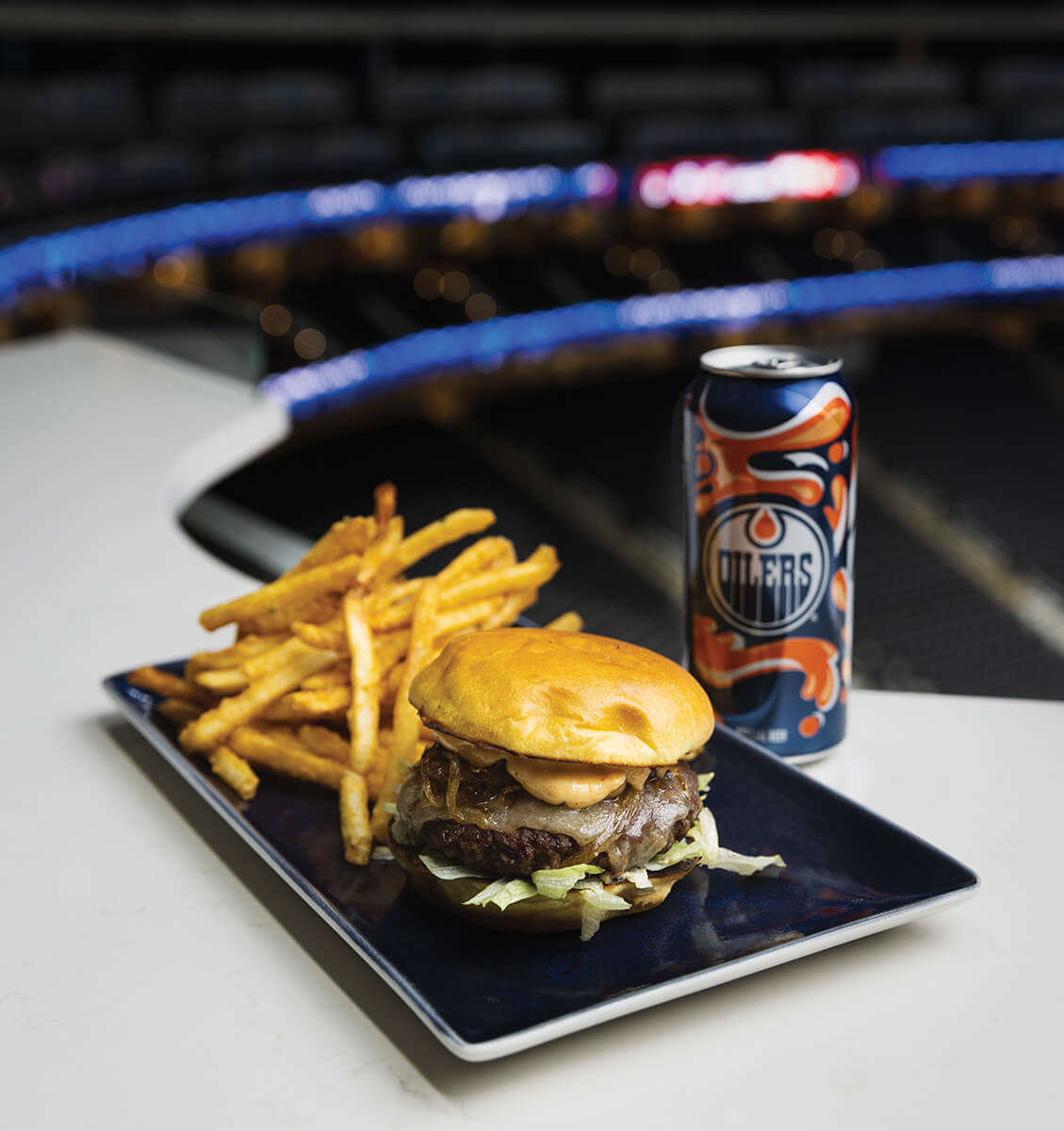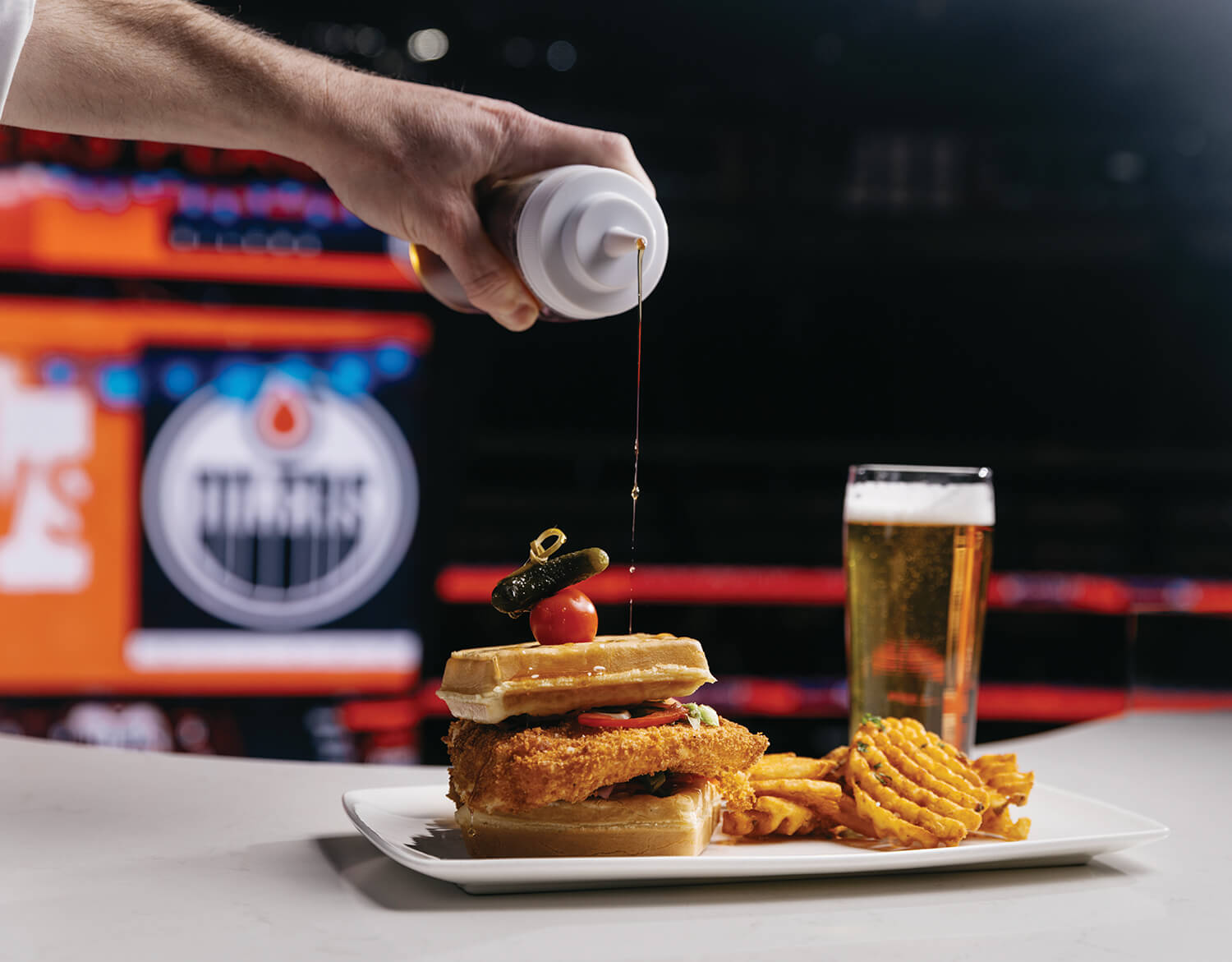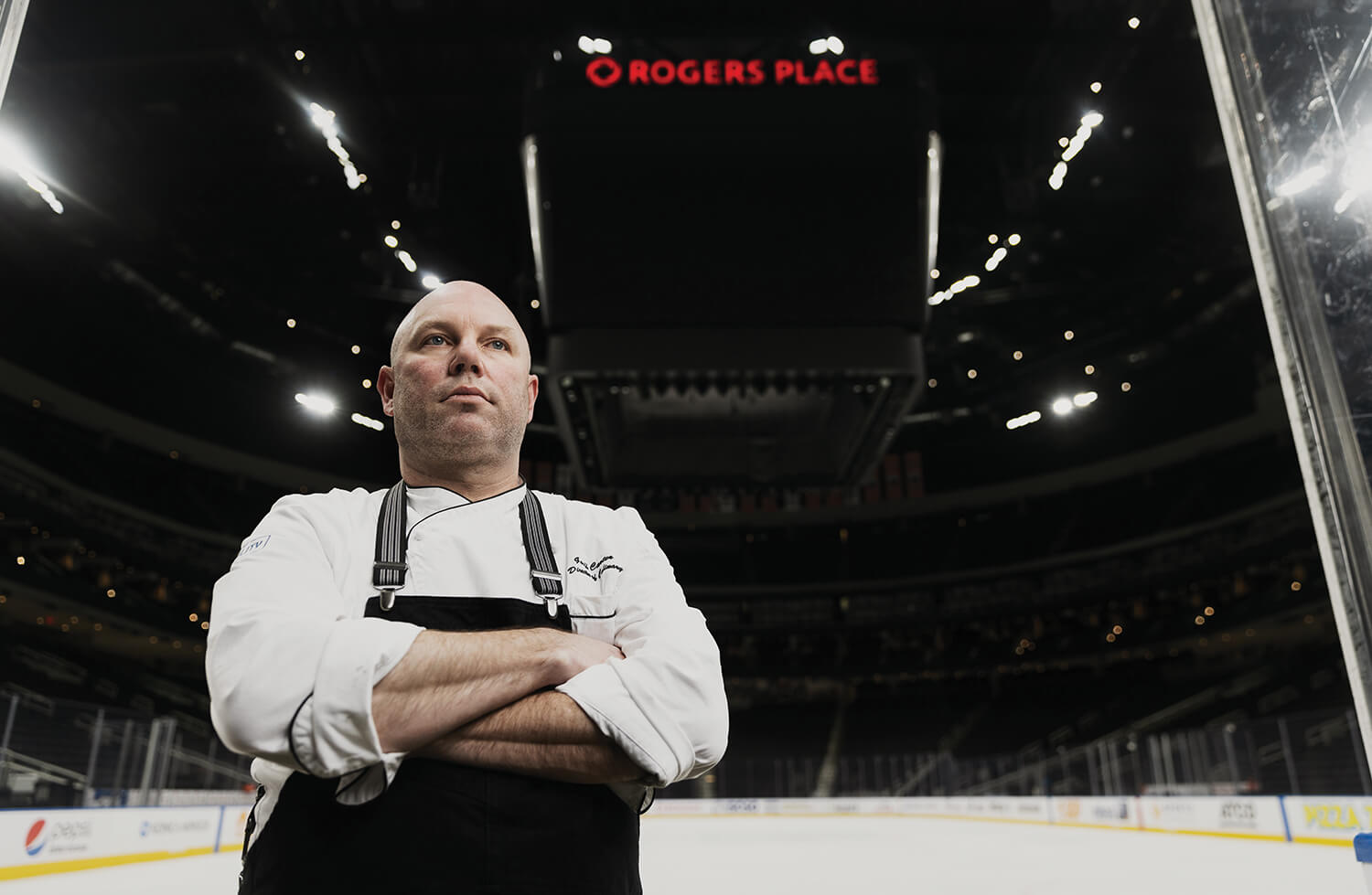
Two hours before the Oilers hit the ice, Geoff Carter begins his tour of Rogers Place.
He goes from concession to concession, from serving counter to serving counter and into the kitchens. As the new executive chef at Rogers Place, it’s his job to oversee food service to more than 18,000 fans per night
He also makes meals for the Oilers players. Carter moved from Ontario to Alberta to take the job as the arena’s executive chef in October. One thing might surprise you: He didn’t take the job because he lives and breathes hockey. He doesn’t like watching sports at all.
“To be honest, I watch the Oilers just as much as I watched the Leafs before I moved — which is, not at all,” he says. “I had a friend ask me if I made meals for the Oilers. I said I did, and he said, ‘You don’t know them at all, do you?’”
The fact that Carter isn’t a devotee of what’s happening on the ice is actually a good thing. He isn’t distracted when the crowd roars. He’s concerned about the food — from the popcorn and hotdogs to the Alberta barbecue platters served to patrons in the suites. He’s previously cooked in major Toronto venues like the Royal Canadian Yacht Club and the Enercare Centre at Exhibition Place, so he understands the challenge of designing dishes that a staff of hundreds can replicate for thousands of potential patrons.
While the Oilers ride the ups and downs of an NHL season, the fact is that what happens on the ice is only part of the gameday experience. The modern sports fan expects more comforts than ever, from quick WiFi to food and drink options that are more than popcorn or hotdogs, cola or beer.
Depending if you’re eating at the seats in the upper deck, at a table in the loge, in the suites or having a post-game bite at the Studio 99 lounge just up the stairs from the main 104th Avenue entrance, you could be tasting an Alberta barbecue platter, a Nashville hot chicken sandwich with two slightly sweet waffles serving as the “bread,” or maybe a Mediterranean salad with grilled chicken.

Of course, this will all depend on what limitations are placed on in-arena service by Alberta’s health authorities, thanks to the ever-changing nature of the COVID-19 pandemic.
The virus has forced teams and arena operators to close their doors, reopen them, limit seating, open up seating, close doors again, reopen them again, change dining protocols… you get the idea.
In 2020, COVID-19 forced the NHL to abandon playing games in packed arenas — eventually going to Edmonton- and Toronto-based “bubbles” to finish the playoffs. The Dallas Stars and Tampa Bay Lightning contested the Stanley Cup final in front of pretty well no one but the TV cameras at Rogers Place.
More chaos was to come in 2020-21, as Canadian and American authorities took wildly different tacks when it came to addressing the pandemic. Canadian teams played a shortened 2020-21 regular season in empty arenas, without crossing the border. Meanwhile, American teams played games in front of capped-capacity crowds.
For the better part of two years, life was anything but normal across the league, and it gave arena managers time to evaluate what they were doing well, what they could change and, most important, predict what fans would want once seating restrictions were lifted.
And then the 2021-22 season arrived, with what looked to be a new lease on life for the league. With vaccination-restriction exemptions, the Oilers could go to 100 per cent capacity for home games. For the first two months of the season, things were joyous. The arena was nearly full, and the Oilers were near the top of the standings.
But then the Omicron variant exploded in Alberta in December of ’21, forcing the World Junior Hockey Championships in Edmonton and Red Deer to be abandoned. And the Oilers, like other Canadian teams, had to cut capacity. Games were postponed, as the NHL wanted to avoid playing games in empty or half-empty Canadian arenas, while it was business as usual for the teams playing home games on American soil.

According to Stu Ballantyne, president and chief operating officer of Rogers Place and Ice District, staff redirected15 pallets of food that were sup-posed to be used for home games in December and January to food banks.
When the occasional Oilers home games were played early in 2022, fans could not be unmasked in the general seating areas, so they couldn’t eat or drink at the seats. Water stations had to be installed, in the wake of con-course concession stands being closed. But, freestanding restaurants like Molson Hockey House and Studio 99 could remain open. Loge patrons could not consume food at the tables overlooking the ice surface, while suites and theatre boxes, being closed-off areas, could have food service.
“We were just trying to find as many options as we could,” Ballantyne says of working through the restrictions. “Trying to make everyone happy was not going to happen for a while, until the restrictions were lifted again.”
It’s been a rollercoaster of a year, a heck of a time to debut a new arena menu.
When fans came back in October, it was clear that they wanted to see the classics done well. Coming back to the arena would be like visiting with an old friend for a favourite dinner. They wanted familiarity, to connect to a time before COVID. Ballantyne says Alberta beef and perogies are mainstays, and that moves were made to improve the hot dogs and hamburgers, to allow the new chef and a new food-service provider the chance to put their stamps on a new arena menu for 2021-22.
“There’s no question that sporting events have a typical type of menu,” says Ballantyne. “There’s always nuances in every region in North America. But we saw that people wanted to get out, that it was like someone had been pulling on their reins for so long. We saw food sales increase once we opened up the season [in October] and have 100 per cent capacity and then our full food program. It was really good coming out of the gate, right up to when the restrictions came back into play.”

Reopening Rogers Place for the 2021-22 season was not easy. Not only did supply chain issues make it difficult to bring in ingredients, OEG officials had to guesstimate just how full the arena would be and roll with ever-evolving provincial restrictions. Ordering food is a tricky business when trying to fig-ure out if the arena would be half full or sold out. And suppliers were asking for lead times of up to three or four months, which was unusual.
Then came the staffing challenges. On a regular game night, pre-pandemic, there were 850 staff working. But — not only in Edmonton, but in arenas across the league — workers weren’t coming back. Many people held arena jobs as their second gigs and, once COVID struck, they’d decided to stick with one vocation. As well, the team changed food-service providers in July 2021, so the workers had to be re-hired under the new partner’s banner. Some decided not to come back after the changeover.
“We had to re-staff,” says Ballantyne. “All of those people had to be re-hired under a new company. Many of them just disappeared during that process, and, coming into the new season (2021-22) we were concerned, like everyone else in the hospitality industry, of what we could open. And, to be honest, we held back on some of the menu items, just so we knew what we could deliver would be done at a high level.”
The new menu at the arena wasn’t fully launched till late November, because it had to be rolled out slowly.
“We have to gear up by the month, not the day,” says Ballantyne. “You want to make sure you are managing the cost of goods. The other thing is space. Even though this is one of the largest arenas in the NHL, you still have to be able to store every-thing. Managing inventory, dealing with how much we have in the building and how much we have to prep, it’s tough.”
Carter and his staff face other challenges. A food item that works well in the lounge or in the loge doesn’t work in the seats. Chicken wings are popular when fans can eat at a table, but in the seats, they’re messy — and what to do about the bones? Fans in the seats want food that is consumed — and leaves no trace. That’s why an estimated 3,600 bags of popcorn are sold per game (making it by far the No. 1 item). That’s why so much time is spent thinking about hotdogs and burgers.
And, the arena itself makes serving food difficult.
Before fans enter the building, the temperature is set for 14-15 Celsius. After all, the game is played on ice, so it’s not like the building is supposed to be balmy inside. But a surge of fans pushes that to 20 Celsius, then the air conditioning slowly brings that down again.
“The buck stops with me, because the ice staff and the engineering staff also report to me,” says Ballantyne. “We have the food and beverage on one side, but we also want to make sure we’re providing some of the best ice in the league. We’ve been voted by the Players’ Association No. 2 [ice in the NHL] for many, many years. But, the reality is you have to balance that with 18,000 people coming in and raising the heat. And then the food service. Working with Geoff and everyone at ICE District Hospitality, the deal was ‘hot food hot’ when it gets to the customer.”
While the loge area offers the ability — in normal times — for patrons to dine at tables while they watch the game, it’s also out in the open, so it gets blasted by the air conditioning while the suites are protected. So, the team paid particular attention to the loge area — and the natural quartz tables that suck up the cold air. Instead of changing the serving surfaces, Ballantyne said extra measures were taken to change the food prep, to get food as quickly as possible from the kitchen to the customer.
When I meet with Carter, we’re in Studio 99. It’s the signature lounge, filled with memorabilia that came from Wayne Gretzky’s private collection. It’s a place to sit and enjoy items ranging from the brisket nachos to a tomahawk steak.
Studio 99 opened in 2018, replacing the Curve restaurant concept that was introduced when Rogers Place first opened its doors two years prior. Curve was an attempt to bring a more suit-and-tie space to the hockey experience. If you’ve ever been to a game in Toronto, the suite area is filled with people who look like they’re about to shake hands on multimillion-dollar mergers. The neckties outnumber the jerseys. And, in fact, the TVs display stock prices as well as scores.
But Edmontonians don’t go to Oilers games to finalize deals. And the Oilers learned that lesson quickly. They recognized Curve was a square peg.
“Toronto and Montreal and, to an extent, Vancouver, because of commute times, you don’t go home after work then go to a game,” says Ballantyne. “So, you go right from work to the game. Whereas, in Edmonton, the tendency is that people go home, grab their friends and come on down to take in the game. It’s a jerseys-and-jeans crowd. They are very much a hockey crowd, a little less corporate, even though people do come from the corporate world to watch. They are a little more of the ‘hockey fan’ than the ‘corporate fan.’ We have to cater to what people want to enjoy; it’s not the five-star dinner. We do offer very high-end service, but we also have to offer a high-quality product served in a timely manner.”
Coming out of the pandemic shutdown of pro sports, the bar is set high-er than it ever was before when it comes to what fans expect out of a game night experience. And while everyone in sports marketing will tell you that having a winning team and stars like Connor McDavid and Leon Draisaitl will be a magnet for fans, the home team is not going to be victorious every night. There will be that night where a family comes into town for the one Oilers game they will see all season, and Edmonton will be on the wrong end of the score. But those fans have to go home and still feel they had a great experience at the arena.
The fact is, we are not Europe or South America. Fans in North America don’t come to the arena and sing and make their own entertainment. They expect to be treated to a show.
So, to quote the great NFL wide receiver Terrell Owens, “Get your popcorn ready!” And, that’s 3,600 bags of popcorn, thank you very much.
Like this content? Get more delivered right to your inbox with Ed. Eats
A list of what’s delicious, delectable and delightful.
This article appears in the March 2022 issue of Edify









